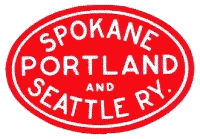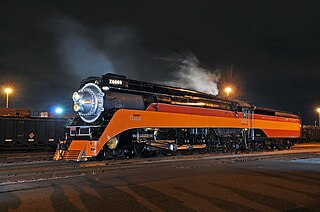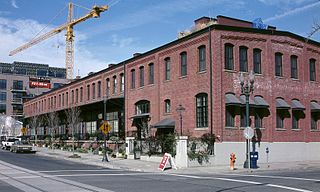Related Research Articles

Lamont is a town in Whitman County, Washington, United States. The population was 70 at the 2010 census.

The Burlington Northern Santa Fe (BNSF) Railway Company is the largest freight railroad network in North America. One of seven North American Class I railroads, BNSF has 41,000 employees, 32,500 miles (52,300 km) of track in 28 states, and more than 8,000 locomotives. It has three transcontinental routes that provide rail connections between the western and eastern United States. BNSF trains traveled over 169 million miles in 2010, more than any other North American railroad.

The British Rail Class 08 is a class of diesel-electric shunting locomotive built by British Railways (BR). As the standard BR general-purpose diesel shunter, the class became a familiar sight at major stations and freight yards. Since their introduction in 1952 however, the nature of rail traffic in Britain has changed considerably. Freight trains are now mostly fixed rakes of wagons, and passenger trains are mostly multiple units, neither requiring the attention of a shunting locomotive. Consequently, a large proportion of the class has been withdrawn from mainline use and stored, scrapped, exported or sold to industrial or heritage railways.

The Burlington Northern Railroad Bridge 5.1 or BNSF Railway Bridge 5.1, also known as the St. Johns Railroad Bridge or the Willamette River Railroad Bridge, is a through truss railway bridge with a vertical lift that spans the Willamette River in Portland, Oregon, United States. Built by the Spokane, Portland and Seattle Railway (SP&S) and completed in 1908, it was originally a swing-span bridge, and its swing-span section was the longest in the world at the time. However, 81 years later the main span was converted from a swing-type to a vertical-lift type, in order to widen the navigation channel. The lift span is one of the highest and longest in the world. The bridge consists of five sections, with the two sections closest to the bank on each side fixed.

The Spokane, Portland & Seattle Railway (SP&S) was a railroad in the northwest United States. Incorporated in 1905, it was a joint venture by the Great Northern Railway and the Northern Pacific Railway to build a railroad along the north bank of the Columbia River. Remnants of the line are currently operated by BNSF Railway and the Portland and Western Railroad.

The North Coast Limited was a named passenger train operated by the Northern Pacific Railway between Chicago and Seattle via Bismarck, North Dakota. It started on April 29, 1900, and continued as a Burlington Northern Railroad train after the merger on March 2, 1970 with Great Northern Railway and the Chicago, Burlington and Quincy Railroad. The next year, it ceased operations after the trains which left their originating stations on April 30, 1971, the day before Amtrak began service, arrived at their destinations.

The Portland and Western Railroad is a 466-mile (750 km) Class II railroad serving the U.S. state of Oregon, and is a wholly owned subsidiary of shortline and regional railroad holding company Genesee & Wyoming Inc. The PNWR includes a subsidiary, the Willamette and Pacific Railroad.

Southern Pacific 4449, also known as the "Daylight", is the only surviving example of Southern Pacific Railroad's "GS-4" class of 4-8-4 "Northern" type steam locomotives and one of only two GS-class locomotives surviving, the other being GS-6 class 4460 at the Museum of Transportation in St. Louis, Missouri. The locomotive is a streamlined Northern type steam locomotive built by the Lima Locomotive Works in May 1941. GS is abbreviated from "Golden State", a nickname for California, or "General Service".

Spokane, Portland & Seattle 700 is the oldest and only surviving example of the class "E-1" 4-8-4 "Northern" type steam locomotive and the only surviving original Spokane, Portland and Seattle steam locomotive. It was built by the Baldwin Locomotive Works in May 1938. Nearly identical to the class "A-3" Northerns built for Northern Pacific Railway, it burns oil instead of coal.

Burlington Northern Railroad Bridge 9.6 or BNSF Railway Bridge 9.6, also known as the Columbia River Railroad Bridge, is through truss railway bridge across the Columbia River, between Portland, Oregon, and Vancouver, Washington, owned and operated by BNSF Railway. Built by the Spokane, Portland and Seattle Railway (SP&S) and completed in 1908, it was the first bridge of any kind to be built across the lower Columbia River, preceding the first road bridge, the nearby Interstate Bridge, by a little more than eight years.
Spokane, Portland and Seattle Railway No. 6 was the only locomotive in Class A-2. Purchased from the Northern Pacific Railway for A. B. Hammond's Astoria and Columbia River Railway, number 6 came to the SP&S secondhand. It was used as a switch locomotive until 1931 when it was sold to the St Helens Terminal and Dock Co. at St. Helens Oregon.
Spokane, Portland and Seattle Railway's Class A-3 was a class of 0-6-0 steam locomotive switchers.
Spokane, Portland and Seattle Railway Class L-1 was a class of 4-4-0 steam locomotives built in 1889 by Schenectady Locomotive Works.
Spokane, Portland and Seattle Railway's Class L-2 was a class of 4-4-0 steam locomotives.
The Spokane, Portland and Seattle Railway (SP&S) class L-4 steam locomotives were originally used by the Astoria and Columbia River Railroad (AC&R). They became SP&S locomotives when the SP&S acquired the A&CR.
Spokane, Portland and Seattle Railway Class L-5 was a class of 4-4-0 steam locomotives built in 1897 by Schenectady Locomotive Works.
On the American Spokane, Portland and Seattle Railway, locomotive number 525 was the only steam locomotive in SP&S class O-2. It was originally built for Northern Pacific by the Schenectady Locomotive Works. Builders number 46878 was built in February 1910.

Spokane Portland and Seattle Railway's E-1 class was a class of the only three 4-8-4 locomotives built by the Baldwin Locomotive Works in 1938. The E-1 class "Northerns" were very similar to the A-2 through the A-5 class "Northerns" on the Northern Pacific Railroad built by Baldwin from 1934–1943. Visually, the locos are near-identical. The only difference is that the Northern Pacific Railroad 4-8-4s burn coal and the 4-8-4s on the Spokane, Portland & Seattle Railroad burn oil.

The North Bank Depot Buildings, in central Portland, Oregon, United States, are a pair of buildings formerly used as a freight warehouse and passenger terminal for the Spokane, Portland and Seattle Railway (SP&S). Formed in 1905, the SP&S was commonly known as the North Bank Road during the period in which these buildings were in use. The Portland buildings' passenger facilities were also used by the Oregon Electric Railway after that railway was acquired by the SP&S. Located in what is now known as the Pearl District, the buildings were listed on the National Register of Historic Places in 1996. They were in use by the SP&S and its successor, Burlington Northern Railroad, from 1908 until the 1980s. Only the east building was used as a passenger station, and this usage lasted from 1908 until 1931.

Spokane, Portland and Seattle Railway No. 539 is the only preserved example of the class O-3 2-8-2 "Mikado" steam locomotive. It was built by the American Locomotive Company in 1917 for the Northern Pacific Railway as engine No. 1762. It was sold to the NP's subsidiary, the Spokane, Portland and Seattle Railway and renumbered 539, in 1944. The locomotive was retired in 1957, and it was displayed in Esther Short Park, Washington, until 1997. That year, it was moved to Battle Ground for a potential restoration that never came to fruition. In 2007, it was acquired by the Grand Canyon Railway and moved to Williams, Arizona for an operational restoration that also never came to fruition. In 2019, the 539 was purchased again by the Port of Kalama, who moved it back to Washington with the hopes of putting it on static display inside a visiting center that was constructed in 2014.
References
- 1 2 3 Gartner 1990, p. 206.
- 1 2 3 4 Gartner 1990, p. 14.
- ↑ Wood & Wood 1974, p. 151.
- 1 2 Gartner 1990, p. 16.
- ↑ The Northwest's own Railway. numbers 3 and 4. The Spokane Portland and Seattle Railway Historical Society. 1998. p. 9.
- ↑ Gartner 1990, p. 70.
- Gartner, John T (1990). North Bank Road, The Spokane Portland and Seattle Railway. WSU Press.
- Wood, Charles R; Wood, Dorothy (1974). Spokane Portland and Seattle Railway. Superior Publishing Co. p. 151.